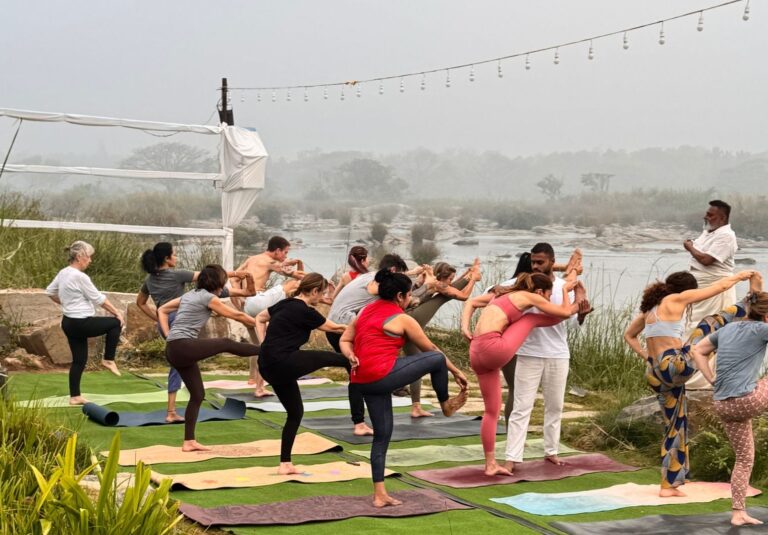In a world where our days often feel like a race against time, many people ask themselves: “How do I slow down, feel centered, and live with purpose?” The search for balance is universal, yet the solutions often feel temporary—quick fitness routines, short-lived wellness trends, or fleeting self-help advice.
That’s where the ideology of this blog begins: to show how an Ashtanga yoga shala is not just a place to practice yoga, but a space that transforms how you live each day. Unlike routines that come and go, Ashtanga builds discipline, focus, and mindfulness that ripple far beyond the mat. This blog aims to answer the very questions many seekers have—why Ashtanga, why Mysore, and how does it really impact my daily life?
Why do people turn to an Ashtanga yoga shala for daily structure?
The biggest challenge people face is sticking to a routine. Many start with good intentions, but soon slip back into old habits. An Ashtanga yoga shala solves this by creating an environment of accountability and rhythm. Practice begins at set times, and the structure of the sequences teaches discipline naturally.
Students often say that once they start showing up daily, their mornings become purposeful and their days more balanced. The practice stops being a “class” and becomes a lifestyle anchor.
How is a Mysore yoga school different from a regular yoga studio?
A common question is: “What’s special about Mysore-style practice?” In a Mysore yoga school, you don’t follow a one-size-fits-all class led from the front. Instead, you move through your sequence at your own pace while the teacher offers one-on-one guidance.
This makes it possible for beginners and advanced practitioners to share the same space without feeling pressured. Students often share that this approach helps them grow steadily and safely, unlike fast-paced group classes where it’s easy to feel lost.
Can practicing Ashtanga improve mental focus and reduce stress?
One of the biggest pain points today is mental overload. People wonder: “Will yoga really help me calm my mind?” The answer is yes. Ashtanga works on more than just the body. The rhythm of breath with movement creates a meditative flow that reduces stress and improves concentration.
Many professionals who practice regularly say they can handle workplace pressure better, sleep more deeply, and approach challenges with greater clarity. In other words, the discipline learned in the shala extends to mental resilience.
Why is Ashtanga vinyasa yoga teacher training so sought after?
Some ask: “If I don’t want to teach, is training worth it?” The truth is, Ashtanga vinyasa yoga teacher training is not just for future instructors. It’s an immersive experience that deepens your practice, teaches anatomy, philosophy, and breathwork, and helps you connect with the tradition on a deeper level.
Many students pursue teacher training simply to strengthen their own foundation. Later, some choose to share their knowledge, while others use it purely as a personal journey toward balance.
How does a yoga institute in Mysore bridge tradition and modern life?
Why Mysore? That’s a question many ask. The answer lies in heritage. A yoga institute in Mysore preserves the lineage of Ashtanga while adapting to modern lifestyles. Students follow classical sequences taught by masters, but they also receive guidance on nutrition, mindfulness, and healthy routines.
This blend of tradition and modern support makes Mysore unique. It’s not just about practicing yoga—it’s about learning how to live more consciously in a world that constantly pulls you in different directions.
What real-life changes do people experience after consistent practice?
Consistency brings transformation. Practitioners often notice:
-
- More energy throughout the day.
-
- Better sleep quality and digestion.
-
- Improved patience and emotional control.
-
- A stronger, more flexible body.
-
- Greater confidence and self-awareness.
These changes show that yoga is not just physical exercise—it’s a holistic lifestyle practice.
How do you maintain balance once you leave the shala?
One concern many share is: “How do I take the benefits into daily life?” Practicing in an Ashtanga yoga shala builds habits you carry everywhere. Small practices like mindful breathing before stressful meetings, eating more consciously, or taking a pause to stretch during work all stem from the discipline you cultivate inside the shala.
This is how balance shifts from being a temporary feeling to a daily reality.
Living with Balance, On and Off the Mat
Finding balance is not about quick fixes—it’s about creating small, sustainable changes that become second nature. An Ashtanga yoga shala offers the foundation to build that balance. In contrast, a Mysore yoga school, an Ashtanga vinyasa yoga teacher training, and a yoga institute in Mysore provide the tools, wisdom, and community to support the journey.
The true gift of this practice is not just physical strength but a way of living with awareness, resilience, and calm in a chaotic world.
For more guidance and opportunities, visit Ashtanga Vinyasa Yogasana.
Key Takeaways:
-
- An Ashtanga yoga shala gives structure, accountability, and consistency.
-
- A Mysore yoga school offers self-paced learning with personal teacher guidance.
-
- Ashtanga practice reduces stress and improves mental clarity.
-
- Ashtanga vinyasa yoga teacher training deepens personal understanding beyond teaching.
-
- A yoga institute in Mysore blends authentic tradition with modern lifestyle guidance.
FAQs:
1. Do I need prior experience before joining an Ashtanga yoga shala?
No, beginners are welcome. The practice grows with you over time.
2. How is a Mysore yoga school helpful for beginners?
It allows students to move at their own pace, with personalized teacher guidance.
3. Is Ashtanga vinyasa yoga teacher training too advanced for regular practitioners?
Not at all. It’s designed to deepen practice, whether you plan to teach or not.
4. Why is Mysore known as the global hub of yoga?
It’s where the Ashtanga tradition began, making it the most authentic place to learn.
5. Can I balance practice with a busy lifestyle?
Yes. Even short, consistent daily practice brings noticeable improvements in energy and focus.


